This was an interesting meeting. Well, actually it was as fun as watching paint dry. But it was informative. H.R. Green Consulting made a presentation to the Transportation Commission. It pretty much confirmed my fears. No on street bike path, but not only that, it appears that the sidewalk is the “trail” a “multi-use” trail for walkers, joggers, skateboarders, rollerbladers, baby strollers, wheel chairs and biking since it is not provided on the street.
Calling it a city sidewalk a trail is a bit like calling I-35E a parkway. oh, wait… it is called it a parkway.
H.R. Green Consulting holds the view that 75th Street is too narrow to have bike lanes and that since the mission of the Three Rivers Park District (formerly Hennepin Parks), which is behind this trail, is to create a multi-use trail AND because there has to be a street for cars – the bike paths have got to go.
First problem – the “Trail” (sidewalk)
The problem with that is the belief that sidewalks are safer than streets for biking. Bicycle side paths such as the one on 75th have proved so dangerous that even the US government instructs that they be used in only the few locations where their dangers are insignificant. The problem is not just pedestrians; urban sidepaths cause difficult and dangerous car-bike conflicts at every driveway and intersection. How so?
A car backing down a driveway will slow down at street level before entering expecting fast moving vehicles. This is not the case for a sidewalk. Not seeing pedestrians the car will back out past the sidewalk to the street .
A car is more likely to see a bicyclist in the street when making a right hand turn but is less likely to see the bicyclist up on the sidewalk entering in to the street when making the turn.
Sidewalks which have been later re-designated as cycle paths may contain various obstructions including bus stops, pillar boxes, telecommunications cabinets and pedestrians.
Cycle paths are generally less frequently cleaned of debris and snow/ice than roads.
Contrary to intuition, cyclists riding on bicycle paths (now called “shared use paths”) have a higher crash rate than cyclists riding on roads, although not as high a crash rate as cyclists riding on sidewalks (Aultman-Hall and Kaltenecker 1998). The risk of injuries on paths compared to roads has been calculated as 40%, 80%, and 260% higher (Moritz 1998, Aultman-Hall and Kaltenecker 1998, Kaplan 1976). Some of the increased risk may be explained by the greater likelihood of inexperienced cyclists to use paths or sidewalks (Aultman-Hall and Adams 1998). However, the studies of bicycle club members, who are much more experienced than average cyclists, reveal a higher crash rate on paths even for these riders.
Second problem – 75th Street with no bike lanes
Bike lanes usually makes both cyclists and motorists feel more comfortable, and, by allowing motorists to pass with less delay at a greater distance, may reduce bad feelings on both sides.
Bike lane stripes serves the same engineering purpose as any other lane stripe, and should be employed under similar circumstances–to delineate travel paths that could otherwise be ambiguous, providing for more predictable movement.
Bike lane stripes may also provide better protection against hijacking roadway space by re-striping it for additional traffic lanes.
Bike lane strips remind motorists that bicycles belong on the road, and to expect them there.
So what to do….
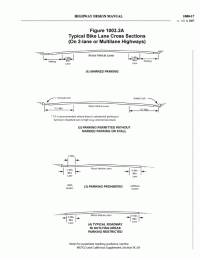 Take a page from the California Highway Design Manual – CHAPTER 1000
Take a page from the California Highway Design Manual – CHAPTER 1000
BIKEWAY PLANNING AND DESIGN
H.R. Green Consulting says that there just is no room for an on-street bike path. There is 60 feet available to work with. H.R. Green Consulting wants the city to create a 26′ road leaving 14′ on north side and 10′ on the south for boulevards and Trail. 10′ of the boulevard on the north side would be made into a trail leaving the boulevard at 14′. So that is a 14′ and 10′ boulevard, amazingly generous by any standard, and given that the south side does not have a sidewalk, its just green space (city property) adjacent to the home owners property. No sidewalks, no nothing.
However, lets say we want to go crazy and add say two bike lanes. One going east and one going west. Crazy. They are proposing 6′ bike lanes on 76th Street. The California Highway Design Manual calls for a 5′ bike lane minimum with curb. So lets say we want to be stingy and go with two 5′ bike lanes times 5′ equals 10′ we subtract that from the boulevard equally leaving 9′ and 5′ boulevards. Still a nice chunk of city boulevard space.
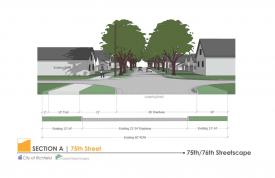 Now did I mention that the road surface without bike lanes is 22′ on 76th Street?
Now did I mention that the road surface without bike lanes is 22′ on 76th Street?
So the road surface on 75th Street as planned is 26′ and if we do another crazy thing like reduce it to… say… 22′ that gives us 4′ to give back to the boulevards. Split equally again the boulevard are now 11′ and 7′ – amazing.
Again, if we take a page out of the California Highway Design Manual we could even squeeze an extra foot of usable space for the bike lanes by blending street with the curb.
So in the end we have from north to south:
Trail 10′ | Boulevard 11′ | Bike Lane 5′ | Roadway 22′ | Bike Lane 5′ | Boulevard 7′ = 60′ total
Why couldn’t H.R. Green Consulting do the math? …and hell I’m not even getting paid.
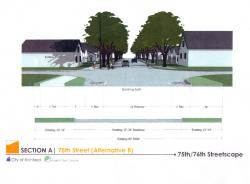

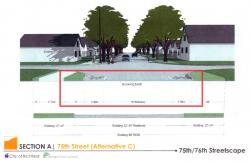

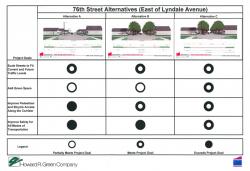
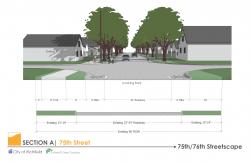
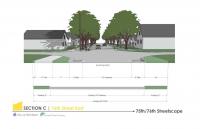
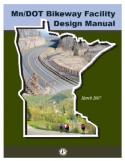 A couple of interesting PDFs on the Technical Guidance for Bikeways put out by Mn/DOT
A couple of interesting PDFs on the Technical Guidance for Bikeways put out by Mn/DOT
